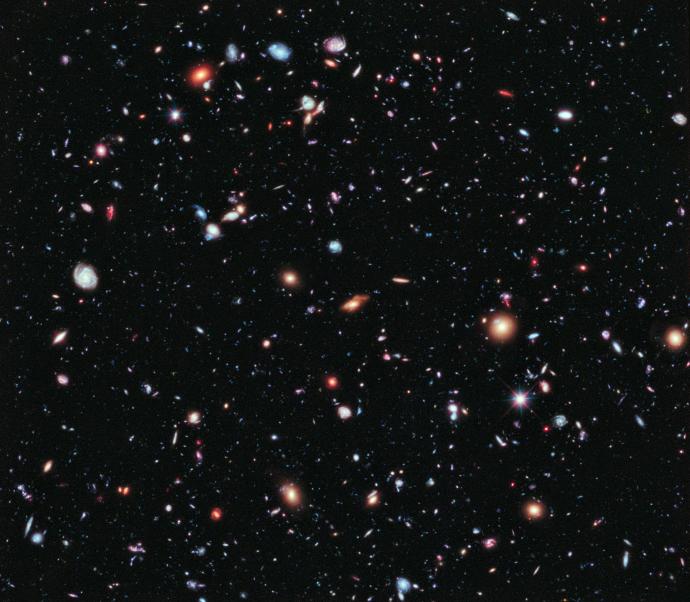Cosmology is the study of the Universe. It doesn't look at small objects, like stars or planets. It investigates the Universe on a large scale.
It uses science to work out how the Universe started and how it changed over time, and predicts what will happen to it in the future.
The Universe is everything there is. It contains all the stars, planets, dust, gas, atoms, dark matter, light, and the space in between. It even includes the laws of physics, like gravity. Everything which exists is part of our Universe.
Even though it contains a lot of stuff, it is also massive. This means, on average, there is only 1 single hydrogen atom for every four cubic metres of volume. So, the Universe is mainly made of nothing!
Only around 5% of its mass is made up of everything we can see. The rest is made of dark matter (27%), which we can't see but can measure, as it still interacts with gravity and dark energy (68%). Dark energy is still completely unknown.

- History of the Universe
For the first tiny fraction of a second after the Big Bang, everything was too hot for us to describe what it was like. It was not like any physics we see now.
But we can use science to work out what happened from as little as 10-43 seconds (or 0.0000000000000000000000000000000000000000001 seconds!) after the Big Bang.
Image CreditThis work by Woudloper is licensed under Creative Commons Attribution Share Alike 4.0 International
CreditThis work by Woudloper is licensed under Creative Commons Attribution Share Alike 4.0 InternationalTime of the history of the Universe Up to 10-6 seconds: Lighter particles
Tiny particles like quarks, electrons and neutrinos exist. At this point, the Universe is too hot and dense for "normal" physics to work. Even forces like gravity act in different ways. Experiments in huge particle accelerators help us work out how physics works in extreme conditions like these.
After 10-6 seconds: Protons and Neutrons created
Until now, the only things that could exist were very light particles. Now the Universe is cool enough for heavier particles to form, like protons and neutrons.
After about 1 second: Making elements
After 1 second, things have cooled down enough for hydrogen nuclei to exist. Some hydrogen nuclei fuse together to make helium nuclei. The large amount of hydrogen in the Universe is one of the pieces of evidence for the Big Bang.
After about 380,000 years: Normal atoms created
The Universe is now cool enough for atoms to exist. Before this point, the Universe was too hot for electrons to stay in orbit around a nucleus.
The atoms release extra energy as photons, or light. So this is also when the Cosmic Microwave Background is created.
After about 400 million years: The first stars
Huge clouds of hydrogen collapse under their own gravity. They become hot enough inside for the first stars to begin shining. These stars create the heavier elements we see across the Universe today.
After 1000s of millions of years: Galaxies form
Gravity pulls clumps of matter together. Huge collections of stars form the first galaxies.
About 5,000 million years ago: Our Solar System forms
Our Solar System forms from a huge cloud of dust and gas in the Milky Way. This dust and gas contains elements which were created inside earlier stars. Over 99% of the cloud becomes the Sun. The rest becomes the planets and other objects of our Solar System.
Today
Today, the Universe contains lots of stuff we can see. Stuff like planets, stars, galaxies, dust, and gas. It also contains stuff we can't see, like dark matter. Even after 14,000 million years, the Universe is still expanding. We do not know yet what will happen to it in the future, but astronomers are working hard to find out.
- The Expansion of the Universe
When we look at galaxies which are far, far away, we see they are all moving away from us. And, the further away the galaxy is, the faster it moves. This is happening because the space between the galaxies is stretching. No matter where you are in the Universe everything appears to move away from you.
In 1929, Edwin Hubble measured the speed at which galaxies are moving away from us. Hubble used his results to make a discovery: the speed of the galaxies was faster the further away they were. This relationship between speed and distance is now called Hubble's Law.
The rate of this expansion is called the Hubble constant. Getting an accurate and precise number for the Hubble constant is very hard. Scientists have used different methods to work it out, but not all the answers agree.
Recent answers suggest the expansion is faster than expected. Astronomers do not yet know why. One idea is there could be some kind of force which is pulling galaxies apart. Astronomers have named this force dark energy.
- What will happen to the Universe?
The fate of the Universe is a balance between these things:
- Its continued expansion
- Gravity trying to pull things together and slow down the expansion
- An unknown force that may be increasing the rate of expansion (called dark energy)
So, the Universe could:
- Continue to expand forever and cool down
- Stop expanding and collapse back in on itself
- Expand at an increasing rate until everything rips apart
Astronomers are trying to find out what will happen. To do this, they need to work out how much mass there is in the Universe. The more mass, the more likely it is that gravity will win.
This mass includes stuff we can see, but also dark matter. They also need to understand if there is such a thing as dark energy and what it is.
